New Stars in "La Bayadère"
"La Bayadère" – chor. Rudolf Nureyev after Marius Petipa
Paris Opera Ballet
Théâtre de la Bastille
Paris
March 11-12, 2006
by Marc Haegeman
copyright 2006 by Marc Haegeman
 While at the Palais Garnier, Teshigawara, Lagraa and Kylián are representing the Paris Opera’s continuing infatuation with contemporary dance and Jean-Claude Gallotta’s Nosferatu is announced as the next ballet to enter the company’s repertory, that friend of old named tradition happily returns at the Bastille in the guise of Rudolf Nureyev’s last great classic La Bayadère.
While at the Palais Garnier, Teshigawara, Lagraa and Kylián are representing the Paris Opera’s continuing infatuation with contemporary dance and Jean-Claude Gallotta’s Nosferatu is announced as the next ballet to enter the company’s repertory, that friend of old named tradition happily returns at the Bastille in the guise of Rudolf Nureyev’s last great classic La Bayadère.
Created for Paris in 1992, La Bayadère has been a favourite with audiences and as a company ballet par excellence a formidable test for the Paris Opera Ballet ever since. Splendidly designed—with sumptuous fantasy sets by Ezio Frigerio and lush costumes by Franca Squarciapino—and intelligently staged, La Bayadère may be Nureyev’s least idiosyncratic take on a Marius Petipa classic, but it is surely one of his most agreeable.
read review
Diversities from the North
“Cinderella”, “Suite from Artifact”, “Middlesexgorge”, “Episodes”
Scottish Ballet
Sadler’s Wells Theatre, London
14-18 March
by John Percival
copyright 2006 by John Percival
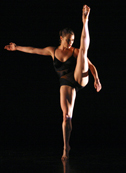 Under its founder-director Peter Darrell, Scottish Ballet was one of Britain’s outstanding companies, with a fine and very distinct repertoire admirably performed by a strong team of dancers. But after his premature death in 1987 it declined under a series of directors and new policies, alleviated at intervals by revivals of a few Darrell ballets and some Ashton borrowings. Then in 2002 Ashley Page was appointed artistic director with a commission to revitalise the company. His backround: principal dancer with the Royal Ballet, most notably in modern works; choreographer since 1982, creating many short works, most of them short-lived. The most popular, “Fearful Symmetries”, seemed to me too obviously a Forsythe imitation, and not as good as Peter Martins’s treatment of the same John Adams score. He made some more interesting ballets for Rambert under Richard Alston’s direction, and has worked also for West Australian Ballet, Dutch National, etc.
Under its founder-director Peter Darrell, Scottish Ballet was one of Britain’s outstanding companies, with a fine and very distinct repertoire admirably performed by a strong team of dancers. But after his premature death in 1987 it declined under a series of directors and new policies, alleviated at intervals by revivals of a few Darrell ballets and some Ashton borrowings. Then in 2002 Ashley Page was appointed artistic director with a commission to revitalise the company. His backround: principal dancer with the Royal Ballet, most notably in modern works; choreographer since 1982, creating many short works, most of them short-lived. The most popular, “Fearful Symmetries”, seemed to me too obviously a Forsythe imitation, and not as good as Peter Martins’s treatment of the same John Adams score. He made some more interesting ballets for Rambert under Richard Alston’s direction, and has worked also for West Australian Ballet, Dutch National, etc.
read review
Letter from
San Franciscso
Ballet Argentino
“Boccatango”
Alain Buffard
“My Lunch with Anna”
Expressions Dance Company
“Virtually Richard3”
March 18, 2006
by Rita Felciano
copyright 2006 by Rita Felciano
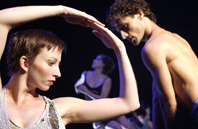 On its first appearance at CalPerformances in 2000, Julio Bocca’s Ballet Argentino left behind the impression of a company with an identity problem. Half of the program was Ana Maria Stekelman’s, choreographing Astor Piazzola tangos. The rest came from a mix of contemporary ballet choreography, with the Pas de Deux from “Don Quixote” thrown in. With the exception of Bocca, these were young performers in not very good choreography.
On its first appearance at CalPerformances in 2000, Julio Bocca’s Ballet Argentino left behind the impression of a company with an identity problem. Half of the program was Ana Maria Stekelman’s, choreographing Astor Piazzola tangos. The rest came from a mix of contemporary ballet choreography, with the Pas de Deux from “Don Quixote” thrown in. With the exception of Bocca, these were young performers in not very good choreography.
read review
Trouping the Classics
"Sleeping Beauty"
Tchaikovsky Perm Ballet
Lehman Center
Bronx, NY
March 11, 2006
"Swan Lake"
Tchaikovsky Perm Ballet
McCarter Theater
Priniceton, N.J.
March 12, 2006
by Leigh Witchel
copyright 2006 by Leigh Witchel
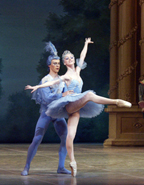 The proper Russian name of The Perm Academic Theater Opera and Ballet—P. I. Tchaikovsky is a mouthful. It’s been shortened while they are touring the United States to Tchaikovsky Perm Ballet or Tchaikovsky Ballet and Orchestra. The identity confusion is typical of translations from Russian to English, but it disappears onstage. Tchaikovsky Perm Ballet isn’t a pickup company. The theater was founded in 1870, the ballet company in the mid-1920s. During World War II the Kirov ballet was evacuated to Perm.
The proper Russian name of The Perm Academic Theater Opera and Ballet—P. I. Tchaikovsky is a mouthful. It’s been shortened while they are touring the United States to Tchaikovsky Perm Ballet or Tchaikovsky Ballet and Orchestra. The identity confusion is typical of translations from Russian to English, but it disappears onstage. Tchaikovsky Perm Ballet isn’t a pickup company. The theater was founded in 1870, the ballet company in the mid-1920s. During World War II the Kirov ballet was evacuated to Perm.
read review
Paradise,
and Paradise Lost
"Four Saints in Three Acts" and "Dido and Aeneas"
The Mark Morris Dance Group
Howard Gilman Opera House
Brooklyn Academy of Music
New York City
March 15, 2006
by Nancy Dalva
copyright 2006 by Nancy Dalva
"...two may and inclined."
Gertrude Stein, "Four Saints" libretto
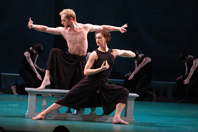 In "Four Saints in Three Acts," Mark Morris follows the Virgil Thompson (1934) score with the Gertrude Stein libretto. Maira Kalman has provided cheerful après Matisse sets—imagine Matisse designing fabrics for a lady's dressing room, all Schiaparelli pinks, and hothouse plush. Elizabeth Kurtzman's costumes for all but the principals suggest a different Matisse—the artist who painted "Spanish Woman with a Tambourine." To enhance this environment—suggested within the closed box set of the stage—Michael Chybowski has been convinced, by someone, to throw off his cloak of darkness and flood the stage with sunshine, and more sunshine. This notion of someplace south, of Iberia, persists throughout. My guess is that this is something along the lines of what Mark Morris thought of at the time as heaven: a southern climate, with gypsies, and castanets, and flamenco dancers, and skies endlessly blue.
In "Four Saints in Three Acts," Mark Morris follows the Virgil Thompson (1934) score with the Gertrude Stein libretto. Maira Kalman has provided cheerful après Matisse sets—imagine Matisse designing fabrics for a lady's dressing room, all Schiaparelli pinks, and hothouse plush. Elizabeth Kurtzman's costumes for all but the principals suggest a different Matisse—the artist who painted "Spanish Woman with a Tambourine." To enhance this environment—suggested within the closed box set of the stage—Michael Chybowski has been convinced, by someone, to throw off his cloak of darkness and flood the stage with sunshine, and more sunshine. This notion of someplace south, of Iberia, persists throughout. My guess is that this is something along the lines of what Mark Morris thought of at the time as heaven: a southern climate, with gypsies, and castanets, and flamenco dancers, and skies endlessly blue.
read review
The Dark Side
“Spindrift,” “Banquet of Vultures,” “Brandenburgs”
Paul Taylor Dance Company
City Center
New York, NY
March 11, 2006 (evening)
by Susan Reiter
copyright 2006 by Susan Reiter
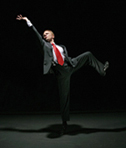 It was hard to enter the theater for a first viewing of “Banquet of Vultures” and not have a strong sense of what was coming. Advance publicity, and a New York Times feature with quotes from Taylor and company members, made it clear that the dance was an anti-war piece, with (according to Taylor) intentional allusions to “The Green Table.” But nothing could prepare one for the utter darkness and depravity of this dance.
It was hard to enter the theater for a first viewing of “Banquet of Vultures” and not have a strong sense of what was coming. Advance publicity, and a New York Times feature with quotes from Taylor and company members, made it clear that the dance was an anti-war piece, with (according to Taylor) intentional allusions to “The Green Table.” But nothing could prepare one for the utter darkness and depravity of this dance.
read review
Top Drawer Taylor
"Arabesque," "Nightshade," "Promethean Fire"
Paul Taylor Dance Company
City Center
New York, NY
March 18, 2006
by Leigh Witchel
copyright 2006 by Leigh Witchel
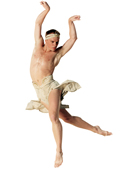 Seven years after its premiere, “Arabesque” is still one of Paul Taylor’s most delicious dances. It’s also the best dance I’ve seen to Debussy’s music, which sensual as it is, is still not dansante. “Arabesque” is a dance for four men and four women, though not quite four couples. Pairings occur, but one woman or man is thrown out from the symmetry to dance solo against the three other couples that form a frieze-like background. French composers like Debussy or Rameau can be a trap; the music is very appealing but can be too regular or thin in structure to hold choreography. Taylor had this problem earlier this season with the Strauss orchestrations of François Couperin in “Spring Rounds”.
Seven years after its premiere, “Arabesque” is still one of Paul Taylor’s most delicious dances. It’s also the best dance I’ve seen to Debussy’s music, which sensual as it is, is still not dansante. “Arabesque” is a dance for four men and four women, though not quite four couples. Pairings occur, but one woman or man is thrown out from the symmetry to dance solo against the three other couples that form a frieze-like background. French composers like Debussy or Rameau can be a trap; the music is very appealing but can be too regular or thin in structure to hold choreography. Taylor had this problem earlier this season with the Strauss orchestrations of François Couperin in “Spring Rounds”.
read review
Choreography by Versace
ODC/SF
Yerba Buena Theater
San Francisco, CA
March 16, 2006
by Paul Parish
copyright 2006 by Paul Parish
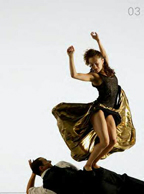 ODC has been in San Francisco now for 30 years, since Brenda Way, Kimi Okada, and star dancer KT Nelson brought the dance department from Oberlin College here looking for a real city to live and work in and perform for. It was a collective back in the 70’s which evolved into the longest running triumvirate in history. Indeed, into a dance empire, since the school they founded also became a presenting organization that has evolved into a major seminary of talent, with mentoring programs for beginners, residencies for emerging choreographers, and two youth companies. At the top of this pyramid is a fantastic cadre of post-modern dancers performing as ODC/SF.
ODC has been in San Francisco now for 30 years, since Brenda Way, Kimi Okada, and star dancer KT Nelson brought the dance department from Oberlin College here looking for a real city to live and work in and perform for. It was a collective back in the 70’s which evolved into the longest running triumvirate in history. Indeed, into a dance empire, since the school they founded also became a presenting organization that has evolved into a major seminary of talent, with mentoring programs for beginners, residencies for emerging choreographers, and two youth companies. At the top of this pyramid is a fantastic cadre of post-modern dancers performing as ODC/SF.
read review
New Ballets from Millipied & Co.
Benjamin Millepied & Company
Joyce Theater
New York, NY
March 14, 2006
by Susan Reiter
copyright 2006 by Susan Reiter
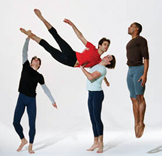 While he has been quite busy as a choreographer in recent years, and last spring offered a New York City program of his own work, this time around Benjamin Millepied added a third hat for this program of four world premieres at the Joyce. In addition to choreographing one work and performing in two, the 28-year-old NYCB principal served as impresario, offering opportunities to three other choreographers. Two (Andonis Foniadakis and Luca Veggetti) are Europeans whose work the French-born Millepied has encountered and admired; the third (Aszure Barton) is a Canadian whose work had been presented in smaller New York spaces but who was receiving a major boost in her visibility on this occasion.
While he has been quite busy as a choreographer in recent years, and last spring offered a New York City program of his own work, this time around Benjamin Millepied added a third hat for this program of four world premieres at the Joyce. In addition to choreographing one work and performing in two, the 28-year-old NYCB principal served as impresario, offering opportunities to three other choreographers. Two (Andonis Foniadakis and Luca Veggetti) are Europeans whose work the French-born Millepied has encountered and admired; the third (Aszure Barton) is a Canadian whose work had been presented in smaller New York spaces but who was receiving a major boost in her visibility on this occasion.
read review
|
|
|